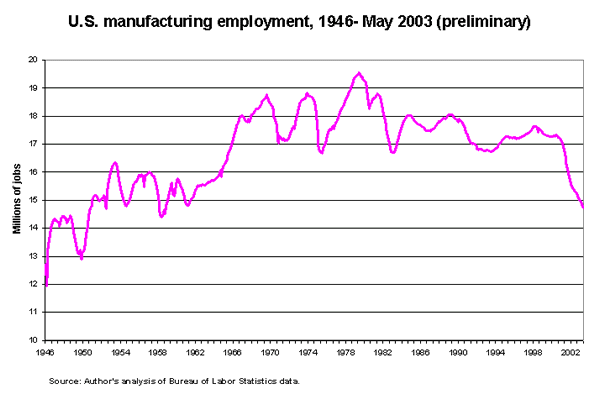Snapshot for June 11, 2003.
The manufacturing crisis continues to deepen
Employment in manufacturing has declined steadily since reaching a high point in March 1998, with job losses accelerating in January 2000 and in the ensuing recession. By March 2001, at the most recent business-cycle peak, manufacturing industries employed 400,000 fewer people than at the previous peak in July 1990.
In the 1990s, for the first time in the postwar period, the U.S. economy actually lost manufacturing jobs during an economic expansion. As shown in the figure below, manufacturing employment declined by 197,000 jobs from the bottom of the last business cycle in March 1991 to March 2001. Manufacturing job losses coincided with the Asian financial crisis, when a flood of cheap imports to the U.S. market cost 170,000 manufacturing jobs between April and December 1998 alone.

By 2000, the U.S. manufacturing sector was the smallest among the major industrialized economies, in relative terms. The decline of manufacturing employment preceded the onset of the recession and continued throughout the recession and thereafter, as manufacturing lost 2.1 million jobs from March 2001 to March 2003 (compared with a net loss of 2.1 million jobs for the economy as a whole).1 The identical rates of job loss in manufacturing and the overall economy indicate that the number of jobs lost in the manufacturing industry is equivalent to the total job loss during that period.
The most current data show that between March 1998 and May 2003, 2.9 million jobs have been eliminated in U.S. manufacturing industries.2 With the loss of another 53,000 jobs in May 2003 alone, the manufacturing industry continues its employment decline.
Notes:
1. Although no official end to the recession has been determined, many economists put the recession’s trough at December 2001, though a recession in the labor market continues.
2. These data reflect recently revised BLS NAICS revisions of industrial categories, which now exclude approximately two million workers in computer and related information processing categories.
This week’s snapshot was co-authored by Robert Scott and Adam Hersh.
Check out the archive for past Economic Snapshots.
